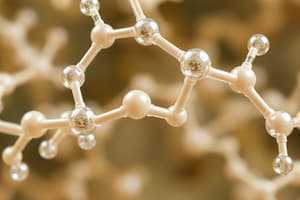Podcast
Questions and Answers
What type of reaction occurs when macromolecules are assembled from monomers?
What type of reaction occurs when macromolecules are assembled from monomers?
- Hydrolysis
- Fermentation
- Condensation/Dehydration Synthesis (correct)
- Dissolution
Which of the following is an example of a simple carbohydrate?
Which of the following is an example of a simple carbohydrate?
- Sucrose (correct)
- Cellulose
- Starch
- Glycogen
What ratio of elements characterizes carbohydrates?
What ratio of elements characterizes carbohydrates?
- 1:1:1
- 1:2:1 (correct)
- 2:1:1
- 2:2:1
What is the primary source of energy among carbohydrates?
What is the primary source of energy among carbohydrates?
In hydrolysis reactions, what is the main result of breaking down macromolecules?
In hydrolysis reactions, what is the main result of breaking down macromolecules?
What distinguishes aldehydes from ketones in molecular structure?
What distinguishes aldehydes from ketones in molecular structure?
Which of the following pairs forms a disaccharide through a glycosidic linkage?
Which of the following pairs forms a disaccharide through a glycosidic linkage?
What is the primary structure of a polysaccharide?
What is the primary structure of a polysaccharide?
Which carbohydrate is primarily involved in glucose storage for plants?
Which carbohydrate is primarily involved in glucose storage for plants?
What structural difference exists between α-glucose and β-glucose?
What structural difference exists between α-glucose and β-glucose?
What is true about oligosaccharides and their digestion in humans?
What is true about oligosaccharides and their digestion in humans?
Which of the following best describes the arrangement of atoms in isomers?
Which of the following best describes the arrangement of atoms in isomers?
What is the main function of dietary fiber in the human diet?
What is the main function of dietary fiber in the human diet?
Flashcards are hidden until you start studying
Study Notes
Macromolecules Overview
- Large molecules, or polymers, composed of smaller structural units called monomers.
- Four major biologically important macromolecules:
- Carbohydrates
- Lipids
- Proteins
- Nucleic acids
Condensation/Dehydration Synthesis Reaction
- Water is removed during the formation of new molecules.
- Monomers combine to form polymers through an anabolic reaction.
- Energy is required, and water is released.
Hydrolysis Reaction
- Breakdown of macromolecules where water is used to disassemble polymers into monomers.
- Catabolic reaction characterized by energy release.
Carbohydrates Functions
- Serve as primary energy sources, e.g., glucose is the main energy source.
- Act as building materials and cell surface markers for communication.
- Contain carbon, hydrogen, and oxygen in a 1:2:1 ratio (Formula: (CH2O)n).
Simple Carbohydrates
Monosaccharides
- Smallest structural units of carbohydrates (C6H12O6).
- Examples include glucose, fructose, and galactose.
- Polar and hydrophilic (water-soluble).
- Characterized by the number of carbons and functional groups, primarily –OH and carbonyl (=O) groups.
Carbonyl Types
- Aldehyde: At the end of the molecule; must have hydrogen attached to C=O.
- Ketone: Located in the middle of the molecule; both R groups are hydrocarbons.
Isomerism
- Isomers are monosaccharides with the same chemical formula but different atom arrangements (e.g., glucose, galactose, fructose all share C6H12O6).
Glucose Variants
- α-Glucose: -OH below the plane of the molecule.
- β-Glucose: -OH above the plane.
Disaccharides
- Formed by two monosaccharides linked through a condensation reaction, creating a glycosidic linkage.
- Examples:
- Glucose + Glucose = Maltose (e.g., in infant formula, beer).
- Glucose + Fructose = Sucrose (e.g., in sugar cane, table sugar).
- Glucose + Galactose = Lactose (e.g., in milk).
Complex Carbohydrates
Oligosaccharides
- Composed of 3 to 10 monosaccharides linked together.
- Example: Raffinose (glucose, galactose, fructose) found in beans, peas, lentils, causing digestive issues due to enzyme lack.
Polysaccharides
- Formed from more than 10 monosaccharides linked, potentially hundreds.
- Types of polysaccharides include:
- Starch: Glucose storage in plants, consisting of amylopectin (branched) and amylose (coiled).
- Glycogen: Glucose storage in animals.
- Dietary Fiber: Not energy-used; includes cellulose (plants) and chitin (organisms).
Starch Sources
- Found in grains, dried beans, pasta, bread, and potatoes.
Studying That Suits You
Use AI to generate personalized quizzes and flashcards to suit your learning preferences.




